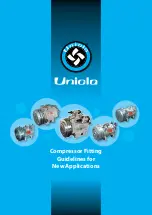
12
© 2016 Emerson Climate Technologies, Inc.
AE4-1402 R4
Assembly Line Brazing Procedure
WARNING
Personal safety equipment must be used during
brazing operation. Heat shields should be
used to prevent overheating or burning nearby
temperature sensitive parts. Fire extinguishing
equipment should be accessible in the event of a
fire.
Figure 5
discusses the proper procedures for brazing
the suction and discharge lines to a scroll compressor.
NOTICE It is important to flow nitrogen through the
system while brazing all joints during the system
assembly process.
Nitrogen displaces the air and
prevents the formation of copper oxides in the system.
If allowed to form, the copper oxide flakes can later
be swept through the system and block screens such
as those protecting capillary tubes, expansion valves,
and accumulator oil return holes. Any blockage of oil
or refrigerant may damage the compressor resulting
in failure.
Pressure Testing
WARNING
Never pressurize the compressor to more than
475 psig (33 bar) for leak checking purposes.
Never pressurize the compressor from a nitrogen
cylinder or other pressure source without an
appropriately sized pressure regulating and relief
valve.
The pressure used on the line to meet the U.L. burst
pressure requirement must not be higher than 475
psig (33 bar). Higher pressure may result in permanent
deformation of the compressor shell and possible
misalignment or bottom cover distortion.
Assembly Line System Charging Procedure
Systems should be charged with liquid on the high side
to the extent possible. The majority of the charge should
be pumped in the high side of the system to prevent low
voltage starting difficulties, hipot failures, and bearing
washout during the first-time start on the assembly line.
If additional charge is needed, it should be added as
liquid
to the low side of the system with the compressor
operating. Pre-charging on the high side and adding
liquid on the low side of the system are both meant to
protect the compressor from operating with abnormally
low suction pressures during charging.
NOTICE:
Do
not operate the compressor without enough system
charge to maintain at least 55 psig (3.8 bar) suction
pressure. Do not operate the compressor with the
low pressure cut-out disabled. Do no operate with
a restricted suction or liquid line.
Depending on the
discharge pressure, allowing pressure to drop below
55 psig (3.8 bar) for more than a few seconds may
overheat the scrolls and cause early drive bearing
damage.
NOTICE
Do not use the compressor to test
the opening set point of a high pressure cutout.
Bearings are susceptible to damage before they have
had several hours of normal running for proper break in.
'Hipot' (AC High Potential) Testing
CAUTION
Use caution with high voltage and never hipot
test when compressor is in a vacuum.
Copeland Scroll compressors are configured with the
motor down and the pumping components at the top
of the shell. As a result, the motor can be immersed
in refrigerant to a greater extent than hermetic
reciprocating compressors when liquid refrigerant is
present in the shell. In this respect, the scroll is more
like semi-hermetic compressors that have horizontal
motors partially submerged in oil and refrigerant. When
Copeland Scroll compressors are hipot tested with liquid
refrigerant in the shell, they can show higher levels of
leakage current than compressors with the motor on
top. This phenomenon can occur with any compressor
when the motor is immersed in refrigerant. The level of
current leakage does not present any safety issue. To
lower the current leakage reading, the system should
be operated for a brief period of time to redistribute
the refrigerant to a more normal configuration and the
system hipot tested again. See
AE4-1294
for megohm
testing recommendations.
Under no circumstances
should the hipot test be performed while the
compressor is under a vacuum.
U.L. sets the requirement for dielectric strength testing
and they should be consulted for the appropriate voltage
and leakage values.
Final Run Test
Customers that use a nitrogen final run test must
be careful to not overheat the compressor. Nitrogen
is not a good medium for removing heat from the
compressor, and the scroll tips can be easily damaged









































